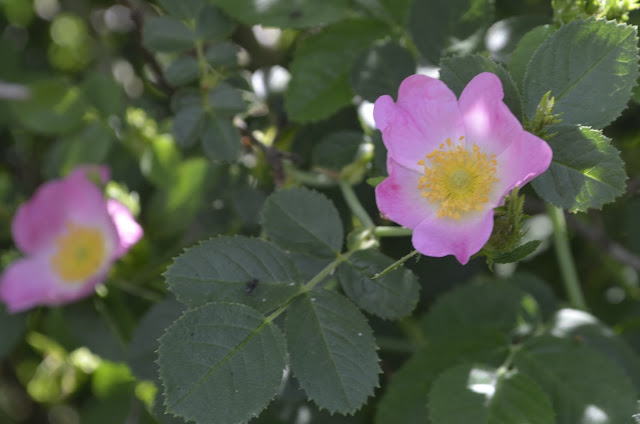Sunday, November 4, 2012
Sweet Briar
I have loved the Sweet Briar rose since the very first time that I crushed its leaves and held them under my nose with my eyes closed...had I not known better, I would have bet a million dollars that it was freshly-sliced crisp green apple in my hands. When it rains, this apple scent radiates out from the plant...it really is an absolute delight.
Having said this, it is considered a weed in certain states of Australia. For example, the following comes from the Victorian Department of Primary Industries:
Scientific name: Rosa rubiginosa L. (Synonym R. eglanteria)
Common Name: Sweet briar, Briar rose, Wild rose.
Sweet briar is native to Europe and western Asia and northern India. Sweet briar was first recorded in Victoria in the 1850s and had established over large areas by 1917. It is now widespread in a variety of cooler, higher rainfall habitats including farmland, woodlands, and stony rises of the volcanic plains, along roadsides and in other disturbed areas.
Sweet briar establishes in areas of moderate soil fertility where there are low levels of grazing. It reproduces from seed and perennial roots and suckers readily from the crown.
Sweet briar is a perennial woody shrub up to 3m tall.
Stems - usually many (and can be up to several hundred) stems arising from the rootstock; erect or scrambling, up to 3 metres high, green and smooth to brown and somewhat roughened, woody, branched, spreading and sometimes trailing, heavily covered with down-curved prickles up to 1.5 cm long.
Flowers - pink or white, 2.5 - 4 cm diameter, on short prickly stalks, occurring in loose clusters at the ends ofstems or branches. Each flower has 5 petals, 8 to 25 mm long, numerous yellowish stamens and five elongated spiny sepals prominent at the base.
Fruit - commonly referred to as a ‘hip’. A smooth or hairy and bristly, egg-shaped capsule, 15 to 20 mm long. Whenripe the hips are orange to red to almost black. The sepals often remain attached to the top of the hip. The hips are shed in Autumn after leaf fall.
Seeds - yellow, 4 to 7 mm long and irregularly shaped.
Roots - stout, shallow and extensively spreading.
Infestations can rapidly take over woodland areas. Patches of the weed can impede the movement of grazing animals and cause serious mechanical injury to stock and dogs. Sweet briar provides harbour for rabbits and other pest animals.
Although a non desirable species, Sweet briar has some favourable characteristics. The hips are a rich source of vitamin C and can be eaten raw. They are used in wines, sauces and jellies. Sweet briar is of some value to apiarists as a source of pollen.
The plant has little or no value as fodder for stock.
This is also a Sweet Briar variety that came up from seed. I planted together two seedlings that were growing at the base of the parent plant (which has since died). Both have the apple scent, but the flowers are slightly different- one being single and the other as above.
Subscribe to:
Post Comments (Atom)


No comments:
Post a Comment